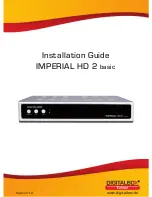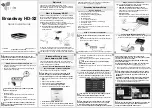
14
Internal Jumper Selection
To access the
DXE-RFS-3
jumper blocks, remove the screws holding the cover of the
DXE-RFS-3
unit. The jumper blocks should be visible and oriented as shown in
Figure 5
.
Important Note:
You cannot use coax for multiple functions. If you are going to use
the coax for directional control, then you cannot use the coax for powering active
elements. Separate cable must be used. We recommend using the default configuration
as shown in the diagram on the previous page
Default Jumper Configuration Settings
Figure 5
shows the default jumper settings for the
DXE-RFS-3
. For JMP1 & JMP2 the center and
top pins of both are shorted. For JMP3 & JMP4, the center and bottom pins of both are shorted.
This recommended configuration is required for control and power connections from the
DXE-EC-
4
Control Console to the
DXE-RFS-3
controller as shown on the previous page.
Figure 5 - Jumper Locations showing Default Settings
JMP1
Selects Power Voltage Source: Coax or J12 - Shown in default position, voltage from J12
JMP2
Selects Direction Voltage Source: Coax or J12 - Shown in default position, voltage from J12
JMP3
and
JMP4
Select Directional Voltage Configuration, either Differential or BCD.
Both Jumpers must be set the same. - Shown in default position for BCD
Optimizing the Array
To determine if the antenna system output level is the limiting factor, tune the receiver to the lowest
band at the quietest operating time. This is usually when propagation is poor but some signals are
heard. Disconnect the antenna and set the receiver to the narrowest selectivity you expect to use.
Receiver noise power is directly proportional to receiver bandwidth (going from 2.5 kHz selectivity
to 250 Hz selectivity reduces noise by 10 dB). Connecting the antenna should result in a noticeable
increase in noise. If so, the array signal level is sufficient and further optimization or amplification
may not be needed.










































